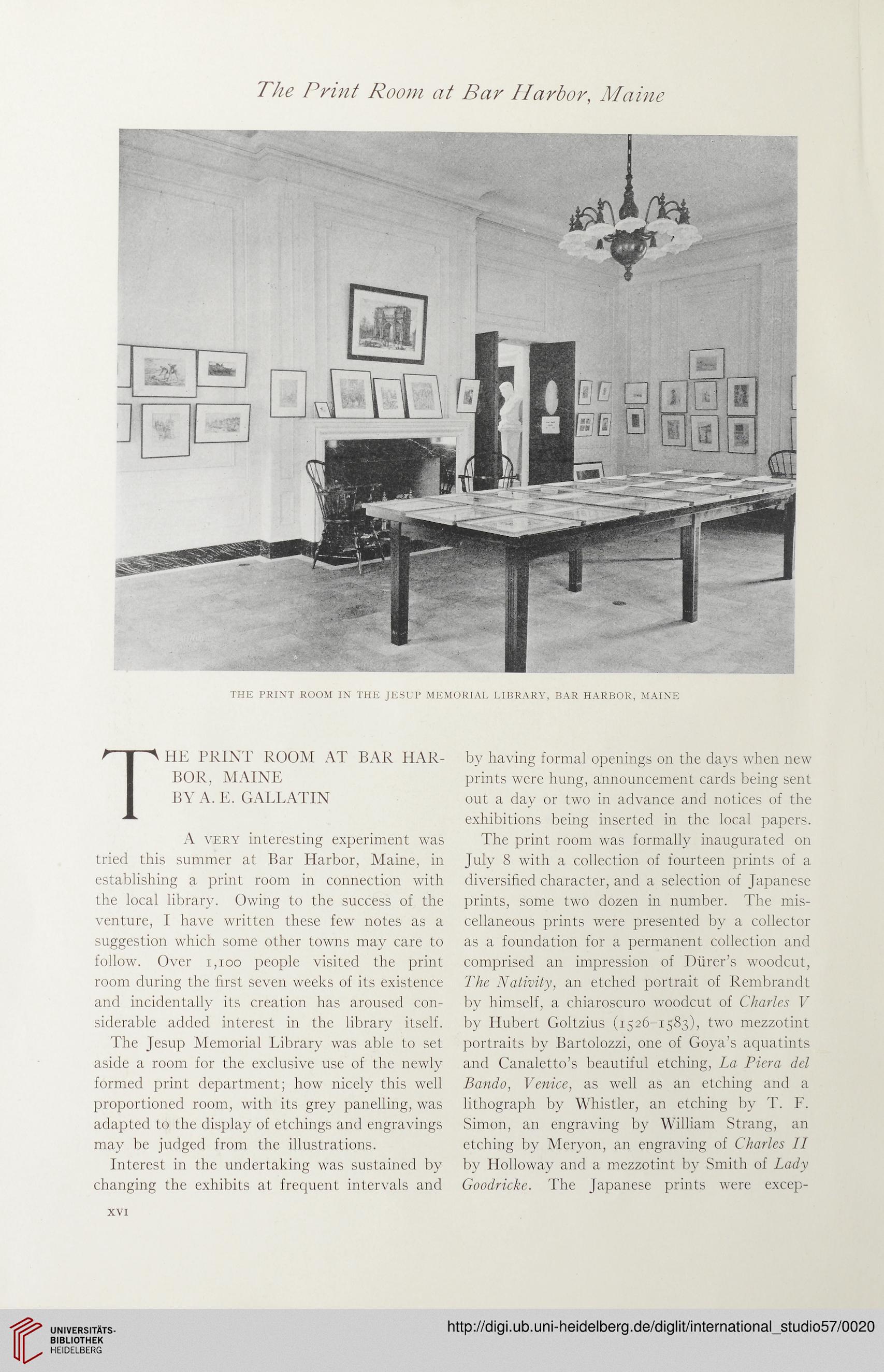The Print Room at Bar Harbor, Maine
THE PRINT ROOM IN THE JESUP MEMORIAL LIBRARY, BAR HARBOR, MAINE
The print room at bar har-
bor, MAINE
BY A. E. GALLATIN
A very interesting experiment was
tried this summer at Bar Harbor, Maine, in
establishing a print room in connection with
the local library. Owing to the success of the
venture, I have written these few notes as a
suggestion which some other towns may care to
follow. Over 1,100 people visited the print
room during the first seven weeks of its existence
and incidentally its creation has aroused con-
siderable added interest in the library itself.
The Jesup Memorial Library was able to set
aside a room for the exclusive use of the newly
formed print department; how nicely this well
proportioned room, with its grey panelling, was
adapted to the display of etchings and engravings
may be judged from the illustrations.
Interest in the undertaking was sustained by
changing the exhibits at frequent intervals and
by having formal openings on the days when new
prints were hung, announcement cards being sent
out a day or two in advance and notices of the
exhibitions being inserted in the local papers.
The print room was formally inaugurated on
July 8 with a collection of fourteen prints of a
diversified character, and a selection of Japanese
prints, some two dozen in number. The mis-
cellaneous prints were presented by a collector
as a foundation for a permanent collection and
comprised an impression of Diirer’s woodcut,
The Nativity, an etched portrait of Rembrandt
by himself, a chiaroscuro woodcut of Charles V
by Hubert Goltzius (1526-1583), two mezzotint
portraits by Bartolozzi, one of Goya’s aquatints
and Canaletto’s beautiful etching, La Piera del
Bando, Venice, as well as an etching and a
lithograph by Whistler, an etching by T. F.
Simon, an engraving by William Strang, an
etching by Meryon, an engraving of Charles II
by Holloway and a mezzotint by Smith of Lady
Goodricke. The Japanese prints were excep-
XVI
THE PRINT ROOM IN THE JESUP MEMORIAL LIBRARY, BAR HARBOR, MAINE
The print room at bar har-
bor, MAINE
BY A. E. GALLATIN
A very interesting experiment was
tried this summer at Bar Harbor, Maine, in
establishing a print room in connection with
the local library. Owing to the success of the
venture, I have written these few notes as a
suggestion which some other towns may care to
follow. Over 1,100 people visited the print
room during the first seven weeks of its existence
and incidentally its creation has aroused con-
siderable added interest in the library itself.
The Jesup Memorial Library was able to set
aside a room for the exclusive use of the newly
formed print department; how nicely this well
proportioned room, with its grey panelling, was
adapted to the display of etchings and engravings
may be judged from the illustrations.
Interest in the undertaking was sustained by
changing the exhibits at frequent intervals and
by having formal openings on the days when new
prints were hung, announcement cards being sent
out a day or two in advance and notices of the
exhibitions being inserted in the local papers.
The print room was formally inaugurated on
July 8 with a collection of fourteen prints of a
diversified character, and a selection of Japanese
prints, some two dozen in number. The mis-
cellaneous prints were presented by a collector
as a foundation for a permanent collection and
comprised an impression of Diirer’s woodcut,
The Nativity, an etched portrait of Rembrandt
by himself, a chiaroscuro woodcut of Charles V
by Hubert Goltzius (1526-1583), two mezzotint
portraits by Bartolozzi, one of Goya’s aquatints
and Canaletto’s beautiful etching, La Piera del
Bando, Venice, as well as an etching and a
lithograph by Whistler, an etching by T. F.
Simon, an engraving by William Strang, an
etching by Meryon, an engraving of Charles II
by Holloway and a mezzotint by Smith of Lady
Goodricke. The Japanese prints were excep-
XVI




